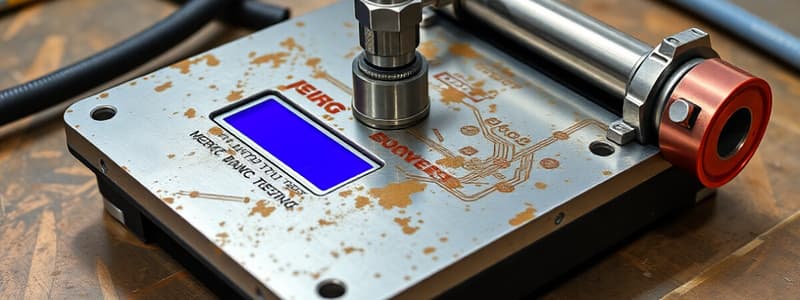Podcast
Questions and Answers
If a piece of equipment is marked as '2.25t', how much does it weigh in kilograms?
If a piece of equipment is marked as '2.25t', how much does it weigh in kilograms?
- 2,250 kg (correct)
- 225 kg
- 2,000 kg
- 200 kg
What is the conversion factor for converting a hundredweight (cwt) to kilograms?
What is the conversion factor for converting a hundredweight (cwt) to kilograms?
- 1 cwt = 200 kg
- 1 cwt = 25 kg
- 1 cwt = 100 kg
- 1 cwt = 50 kg (correct)
What is the approximate weight in pounds of a 1-tonne (metric) object?
What is the approximate weight in pounds of a 1-tonne (metric) object?
- 2,240 lbs
- 2,204 lbs (correct)
- 2,000 lbs
- 1,000 lbs
Which of the following is NOT a standard unit of weight or mass used in lifting equipment?
Which of the following is NOT a standard unit of weight or mass used in lifting equipment?
How many hundredweights (cwt) are there in a US ton?
How many hundredweights (cwt) are there in a US ton?
What is the weight in kilograms of an object weighing 1 US Ton?
What is the weight in kilograms of an object weighing 1 US Ton?
Which of the following correctly represents the conversion factor between a metric tonne (t) and a US Ton?
Which of the following correctly represents the conversion factor between a metric tonne (t) and a US Ton?
If a piece of lifting equipment is rated for a maximum load of 10 US tons, what is the equivalent load in metric tonnes?
If a piece of lifting equipment is rated for a maximum load of 10 US tons, what is the equivalent load in metric tonnes?
What is the primary purpose of the electromagnetic wire rope examination method?
What is the primary purpose of the electromagnetic wire rope examination method?
Which of the following is NOT a benefit of using ultrasonic testing?
Which of the following is NOT a benefit of using ultrasonic testing?
Which NDT method utilizes photographic film or fluorescent screens to detect changes in density and thickness of a material?
Which NDT method utilizes photographic film or fluorescent screens to detect changes in density and thickness of a material?
Which NDT method is considered the least hazardous?
Which NDT method is considered the least hazardous?
Which method relies on detecting breaks and disturbances in the magnetic field to indicate defects in wire rope?
Which method relies on detecting breaks and disturbances in the magnetic field to indicate defects in wire rope?
What is a key limitation of the electromagnetic wire rope examination method?
What is a key limitation of the electromagnetic wire rope examination method?
Which of the following can be detected using both ultrasonic and radiographic methods?
Which of the following can be detected using both ultrasonic and radiographic methods?
What is a unique advantage of ultrasonic testing compared to other NDT methods?
What is a unique advantage of ultrasonic testing compared to other NDT methods?
What is the primary purpose of a bend test?
What is the primary purpose of a bend test?
Which of these is NOT a common material that is often subjected to a bend test?
Which of these is NOT a common material that is often subjected to a bend test?
Why are bend tests commonly performed on welds?
Why are bend tests commonly performed on welds?
When marking lifting equipment, where is stamping ideally preferred?
When marking lifting equipment, where is stamping ideally preferred?
What is the main concern regarding re-marking lifting equipment?
What is the main concern regarding re-marking lifting equipment?
How does the angle of sling legs affect the load in each leg when using multi-leg slings?
How does the angle of sling legs affect the load in each leg when using multi-leg slings?
What is the primary purpose of using a uniform load method when analyzing the forces on a multi-leg sling?
What is the primary purpose of using a uniform load method when analyzing the forces on a multi-leg sling?
What is the main difference between a uniform load method and a trigonometric load method?
What is the main difference between a uniform load method and a trigonometric load method?
Which of the following statements accurately describes the trigonometric method of rating slings?
Which of the following statements accurately describes the trigonometric method of rating slings?
Why is the uniform load method deemed advantageous over the trigonometric method?
Why is the uniform load method deemed advantageous over the trigonometric method?
When using a multi-leg sling with fewer legs than its specified number, what must be considered about the sling's safe working load?
When using a multi-leg sling with fewer legs than its specified number, what must be considered about the sling's safe working load?
What is the main reason for the preference of the uniform load method in many national and international standards?
What is the main reason for the preference of the uniform load method in many national and international standards?
What is the primary drawback of the trigonometric method of rating slings?
What is the primary drawback of the trigonometric method of rating slings?
Which of the following equipment can benefit from the uniform load method of rating, in addition to multi-leg slings?
Which of the following equipment can benefit from the uniform load method of rating, in addition to multi-leg slings?
What is the recommended approach for using the trigonometric method of rating slings?
What is the recommended approach for using the trigonometric method of rating slings?
What is the main reason why using a multi-leg sling with fewer legs than its intended number necessitates a reduced safe working load?
What is the main reason why using a multi-leg sling with fewer legs than its intended number necessitates a reduced safe working load?
What is the purpose of the Charpy V-notch test?
What is the purpose of the Charpy V-notch test?
Which of the following methods is NOT typically used for testing the hardness of lifting equipment?
Which of the following methods is NOT typically used for testing the hardness of lifting equipment?
Which method of hardness testing is most commonly used in the lifting equipment industry?
Which method of hardness testing is most commonly used in the lifting equipment industry?
What is the primary characteristic that the Izod Impact test measures?
What is the primary characteristic that the Izod Impact test measures?
What distinguishes the Izod Impact test from the Charpy Impact test?
What distinguishes the Izod Impact test from the Charpy Impact test?
Why are specimens for the Izod Impact test typically notched?
Why are specimens for the Izod Impact test typically notched?
Which of the following statements about bend testing is TRUE?
Which of the following statements about bend testing is TRUE?
What is the primary purpose of hardness testing in lifting equipment?
What is the primary purpose of hardness testing in lifting equipment?
What is the maximum load that a single leg sling with a WLL of 2t can lift when used at an angle of 30° to the vertical?
What is the maximum load that a single leg sling with a WLL of 2t can lift when used at an angle of 30° to the vertical?
Which of the following correctly describes the mode factor?
Which of the following correctly describes the mode factor?
What is the primary difference between the uniform load method and the trigonometric method for calculating sling assembly WLLs?
What is the primary difference between the uniform load method and the trigonometric method for calculating sling assembly WLLs?
Flashcards
Unit of Measure
Unit of Measure
A standardized quantity used to determine multiple quantities of a physical property.
International System of Units (SI)
International System of Units (SI)
The most widely used system of units consisting of seven base units.
Base Units (SI)
Base Units (SI)
Seven fundamental units from which all other SI units can be derived.
Tonne (Metric)
Tonne (Metric)
Signup and view all the flashcards
Hundredweight (cwt)
Hundredweight (cwt)
Signup and view all the flashcards
Ton (US)
Ton (US)
Signup and view all the flashcards
Imperial Ton
Imperial Ton
Signup and view all the flashcards
Conversion between Units
Conversion between Units
Signup and view all the flashcards
Anomaly Detection
Anomaly Detection
Signup and view all the flashcards
Ultrasonic Testing (UT)
Ultrasonic Testing (UT)
Signup and view all the flashcards
Transducer
Transducer
Signup and view all the flashcards
Echo Interpretation
Echo Interpretation
Signup and view all the flashcards
Radiography
Radiography
Signup and view all the flashcards
Electromagnetic Wire Rope Examination
Electromagnetic Wire Rope Examination
Signup and view all the flashcards
Magnetic Flux Method
Magnetic Flux Method
Signup and view all the flashcards
Magnetic Flux Leakage Method
Magnetic Flux Leakage Method
Signup and view all the flashcards
Hardness Testing
Hardness Testing
Signup and view all the flashcards
Brinell Method
Brinell Method
Signup and view all the flashcards
Charpy Impact Test
Charpy Impact Test
Signup and view all the flashcards
Notch Toughness
Notch Toughness
Signup and view all the flashcards
Izod Impact Test
Izod Impact Test
Signup and view all the flashcards
Bend Test
Bend Test
Signup and view all the flashcards
Impact Properties
Impact Properties
Signup and view all the flashcards
Shock Loading
Shock Loading
Signup and view all the flashcards
Mode Factor
Mode Factor
Signup and view all the flashcards
Working Load Limit (WLL)
Working Load Limit (WLL)
Signup and view all the flashcards
Sling Assembly
Sling Assembly
Signup and view all the flashcards
Trigonometric Method
Trigonometric Method
Signup and view all the flashcards
Uniform Load Method
Uniform Load Method
Signup and view all the flashcards
Design Factors
Design Factors
Signup and view all the flashcards
2 Leg Sling (0°-45°)
2 Leg Sling (0°-45°)
Signup and view all the flashcards
3 & 4 Leg Sling (0°-45°)
3 & 4 Leg Sling (0°-45°)
Signup and view all the flashcards
Ductility Test
Ductility Test
Signup and view all the flashcards
Weld Testing Purpose
Weld Testing Purpose
Signup and view all the flashcards
Marking Lifting Equipment
Marking Lifting Equipment
Signup and view all the flashcards
Stamping Guidelines
Stamping Guidelines
Signup and view all the flashcards
Re-marking Equipment
Re-marking Equipment
Signup and view all the flashcards
Trigonometric Load Methods
Trigonometric Load Methods
Signup and view all the flashcards
Vertical Angle Impact
Vertical Angle Impact
Signup and view all the flashcards
Single Leg Sling Rating
Single Leg Sling Rating
Signup and view all the flashcards
Two Leg Sling Rating
Two Leg Sling Rating
Signup and view all the flashcards
Three Leg Sling Rating
Three Leg Sling Rating
Signup and view all the flashcards
Four Leg Sling Rating
Four Leg Sling Rating
Signup and view all the flashcards
Load Reduction for Multi-Leg Slings
Load Reduction for Multi-Leg Slings
Signup and view all the flashcards
Study Notes
Units of Measure
- A unit of measure is a standardized quantity of a physical property used to determine other quantities of the same property.
- Examples include weight, length, mass, and force.
- Different systems of units are based on different fundamental units.
- The most widely used system is the International System of Units (SI).
- The SI system uses seven base units.
- Other SI units are derived from base units.
- When marking lifting equipment, only one decimal point is used for fractions of a tonne, except for 0.25, which uses two decimal places.
- Some manufacturers use 2.75t, but this format isn't standard.
Symbols and Conversions
- Ton (US): T = Imperial or US Ton = 2000 lbs = 907.185 kg = 0.907t (metric)
- Metric Ton: t = Metric tonne = 1000 kg = 2204 lbs (rounded)
- Imperial Ton: 1 Imperial Ton = 1016 kg = 2240 lbs
- Hundredweight (cwt): 1 cwt = 50 kg
- 1 Ton (imperial) is divided into 20 hundredweights.
Other Useful Conversions
- 1 kg = 2.2 lbs
- 1 inch = 25.4 mm
- 1 foot = 12 inches
- 10kN ≈ 1000 kg
Test Machines and Force/Load Measuring Equipment
- Many product standards specify the required accuracy for force and load measurements.
- Examples include BS EN 818-1 (chain), which requires accuracy of ±1%.
- Test machines and load cells need periodic calibration and verification (ISO 7500-1), typically every 12 months.
- Accuracy should meet the standards and be within ±2% of the nominal load/force.
- ISO 7500-1 has different classes/grades of machines (0.5, 1.0, 2.0) related to accuracy.
- The certificate also specifies the lower limit of calibration.
- This is the minimum load/force that can be read accurately.
- There may also be an upper limit.
Dimensional Measuring Equipment
- Basic tools like tapes and rules (graduated to 1 mm) are commonly used.
- Vernier gauges (0.1 mm gradations) may be necessary for certain items.
Crack Detection
- Basic crack detection (dye penetrant or magnetic particle) is used for general lifting equipment.
- More sophisticated methods (eddy current, radiography, ultrasonic) are used for valued equipment or when safety requirements mandate greater inspection.
Hardness
- Hardness verification of lifting equipment is done using Vickers, Brinell, or Rockwell methods, commonly with Brinell being the most common for lifting equipment inspection.
Bend Test
- A bend test is a qualitative test to determine the ductility/resistance to fracture of a material like metals and polymers.
Marking Lifting Equipment
- Durable markings (e.g., plates, metal tabs, or textile labels) are necessary in low-stress areas.
- Marking in highly stressed areas should meet relevant standards for placement and size.
- If the original marking is lost, additional information should be available.
Trigonometry of Slinging
- The load in sling legs increases with the angle of the leg to the vertical.
- The rating of many multi-leg slings is based on the included angle between sling legs or angle of leg to the vertical.
- The angle of a multi-leg sling leg relative to the vertical is a key concern when rating slings.
The Uniform Load Method
- The uniform load method is simpler and has built-in safety advantages.
- It uses a single, reduced WLL for specific angles, up to 45 degrees, and other WLL's for larger angles.
- The method rates a multipurpose four-leg sling at the same working load limit as a three-leg sling of the same size.
The Trigonometric Method
- This method uses cosine to determine the working load limit at varying angles of the sling to the vertical.
- It is less straightforward and requires calculation of the WLL for each angle.
Multi-Leg Sling User Information
- Reducing the number of legs attached to the load necessitates a reduction in the safe working load.
- Rating is by number of legs used. (4 legs used with only 2, for example.)
Studying That Suits You
Use AI to generate personalized quizzes and flashcards to suit your learning preferences.




